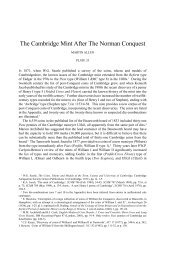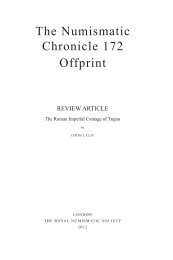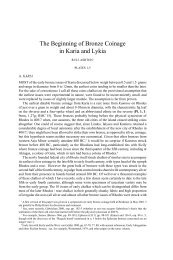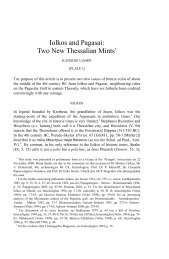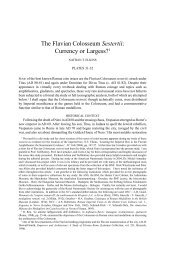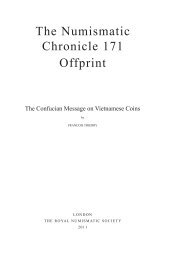The Numismatic Chronicle 171 Offprint - Royal Numismatic Society
The Numismatic Chronicle 171 Offprint - Royal Numismatic Society
The Numismatic Chronicle 171 Offprint - Royal Numismatic Society
Create successful ePaper yourself
Turn your PDF publications into a flip-book with our unique Google optimized e-Paper software.
<strong>The</strong> <strong>Numismatic</strong><br />
<strong>Chronicle</strong> <strong>171</strong><br />
<strong>Offprint</strong><br />
A Fresh Look at Roman Republican<br />
Star Bronzes, RRC 113 and 196<br />
by<br />
RICHARD SCHAEFER and ANDREW McCABE<br />
LONDON<br />
THE ROYAL NUMISMATIC SOCIETY<br />
2011
ROMAN REPUBLICAN STAR BRONZES, RRC 113 AND 196 99<br />
A Fresh Look at Roman Republican<br />
Star Bronzes, RRC 113 and 196<br />
RICHARD SCHAEFER and ANDREW MCCABE<br />
Abstract. <strong>The</strong> Star bronzes RRC 113 and 196 are among the most diffi cult to classify in the<br />
Roman Republican series. Crawford dates RRC 113 to 206-195 BC and RRC 196 to 169-158<br />
BC. Although the as and semis denominations are plentiful and easy to classify, their lower<br />
fractions, except the star-before quadrantes, are rare. <strong>The</strong> traditional dating of fractions with<br />
star above (RRC 113) to 206-195 BC and those with star before (RRC 196) to 169-158 BC is<br />
based on the perception that the plentiful star-before quadrantes are lighter than those with<br />
star above. <strong>The</strong>re are, however, two issues of star-before quadrantes, a rare heavier issue<br />
whose style is close to that of RRC 113, and the much commoner light quadrantes with erratic<br />
design features. <strong>The</strong> latter seem to form part of the large volume of unoffi cial lightweight<br />
semisses and quadrantes produced after 150 BC. Design elements of the other fractions with<br />
star before are consistently like RRC 113, and those with star above are like RRC 196. Thus<br />
we propose to switch the lighter fractions, associating the star-before fractions with RRC<br />
113 in 206-195 BC and the star-above fractions with RRC 196 in 169-158 BC. Although the<br />
offi cial RRC 113 and RRC 196 lower fractions cannot be distinguished from each other by<br />
weight alone, an analysis of weights shows the unoffi cial quadrantes to be consistently much<br />
lighter than the offi cial issues.<br />
1. Introduction and prior research<br />
<strong>The</strong> Roman Republican Star bronzes, Crawford 113 and 196, are among the most<br />
diffi cult to classify in the Republican series. Crawford dates RRC 113 to 206-195<br />
BC (hereafter, Period 1) and RRC 196 to 169-158 BC (Period 2). In 1864 Baron<br />
d’Ailly noted that ‘Les nombreuses monnaies qui portent ce symbole [Astre] offrent<br />
une singulière condition : dans les deux métaux, argent et bronze, et dans chaque<br />
valeur diverse, les têtes au droit ont entre elles, sur toutes les espèces, une certaine<br />
conformité dans les traits de la fi gure et dans les agencements, que l’on ne saurait<br />
méconnaître, malgré la variété de talent des artistes qui ont gravé les coins; tandis que<br />
le revers exhibe souvent des dispositions différentes, soit dans la forme du symbole,<br />
soit sur la place qu’il occupe dans le champ.’ <strong>The</strong> situation is certainly confused by<br />
differences in obverse and reverse style and placement of the star symbol. In this<br />
paper we will try to sort out the confusion.<br />
D’Ailly noted that one style of Star asses and semisses is clearly and consistently<br />
of a higher artistic standard. This style coincides with that of other Period 1 bronzes,<br />
such as those with the rostrum tridens (RRC 114) or bird and rudder (RRC 117B).<br />
<strong>The</strong>se good-style Star asses and semisses, RRC 113/2 and 113/3 (Figs 1, 2) 1 , can<br />
1 Photograph credits. Figs 1, 6, 14, 15, 17: CNG; Figs 2, 12, 16: Andrew McCabe; Figs 3, 4, 5, 7, 8,<br />
9, 10, 11, 13: Roberto Russo.
100<br />
RICHARD SCHAEFER and ANDREW McCABE<br />
easily be distinguished from a number of other Star asses and semisses, which are<br />
artistically less competent and are of slightly lower weight standard although their<br />
weights do overlap with the bronzes of good style. <strong>The</strong> style of these other pieces,<br />
RRC 196/1 and 196/2 (Figs 3, 4), coincides with that of the other Period 2 bronze<br />
issues (for example RRC 192, 193, 194 and 195). So d’Ailly had reached the point<br />
of distinguishing two different issues of Star bronzes.<br />
Fig. 1: Period 1 as Fig. 2: Period 1 semis<br />
Fig. 3: Period 2 as Fig. 4: Period 2 semis<br />
Fractional Star bronzes are all rare except for the very common quadrantes with<br />
star before the prow. D’Ailly divides the corpus into various styles but does not<br />
propose any specifi c arrangement. However, since he notes that the star-before<br />
quadrantes are lighter and more erratically engraved (Figs 12, 13), this is generally<br />
taken to mean that they are to be associated with Period 2 asses and semisses.<br />
D’Ailly did not notice that among the many lower-weight star-before quadrantes in<br />
his own collection there were four that were of higher weight and in style equal to<br />
the fi ne-style (Period 1) asses and semisses. When the star-before quadrantes were<br />
assigned to Period 2, by association the other star-before fractions became linked to<br />
the Period 2 asses and semisses, and, by default, fractions with star above the prow<br />
were linked to the Period 1 fi ne-style series. <strong>The</strong> arrangement is easy to use, the large<br />
denominations being distinguished on the grounds of Period 1 or 2 style, and the<br />
smaller star-before denominations classifi ed to Period 2 and, by default, star-above<br />
to Period 1.<br />
Crawford does not dispute this arrangement. For RRC 113, he illustrates the as.<br />
For RRC 196 he illustrates the as and the quadrans, although the quadrans which<br />
he uses, the key coin in the story, is of a different and fi ner style than that usually<br />
encountered.
ROMAN REPUBLICAN STAR BRONZES, RRC 113 AND 196 101<br />
Neither Grueber nor Sydenham 2 distinguish the issues but rather gather all star<br />
coins together, Sydenham as his catalogue number 264, Grueber as Rome 461-<br />
469. Interestingly Grueber describes the BM quadrantes as ‘exceptionally light<br />
weight’ (3.5 to 5g). He lists in footnotes several varieties which are not in the British<br />
Museum. 3<br />
Two other numismatists have looked at the series, Santini and Zehnacker. 4<br />
Santini reproduces d’Ailly’s arrangement with the addition of further examples. He<br />
admits that the classifi cation presents many diffi culties, such are the irregularities<br />
and inconsistencies of the series, probably stemming from differences in mints and<br />
periods. He repeats the basic classifi cation of the asses into one recognisably goodstyle<br />
main issue (RRC 113/2), and other issues (RRC 196/1). As for the fractions,<br />
the conclusion that the many star-before quadrantes are of lighter weight confi rms<br />
the general classifi cation, but is reinforced by the fact that star-before trientes are<br />
also of lighter weight. So he again supports the classifi cation suggested by d’Ailly.<br />
Zehnacker, while considering the silver in great depth, defers again to d’Ailly on<br />
bronzes, but compounds the misunderstanding of the bronze issues by including<br />
line-drawings of imaginary asses with star before or star under prow and using them<br />
to discuss matters of style.<br />
None of these numismatists commented on the specifi c technical details of the<br />
reverse design, which provide the solution to the classifi cation dilemma.<br />
2. Features of proper RRC 113 asses and semisses (Period 1 style)<br />
As mentioned above, the two denominations that can be classifi ed without diffi culty<br />
are the asses and semisses. <strong>The</strong> following features are present consistently in all<br />
examples of RRC 113 (Figs 1, 2 above and Fig. 5 below):<br />
Reverse:<br />
1. Prow-stem is straight, long and slim.<br />
2. Two close lower wales (horizontal lines above keel but below the mid-wale<br />
line of dots) curve down and, from left to right, converge toward keel.<br />
3. Wales meet in a short rostrum tridens which projects, if at all, only a little past<br />
the hull.<br />
4. <strong>The</strong> A in ROM_ is open, i.e. the bar of the A is angled and is connected to only<br />
one of the two vertical supports of the letter.<br />
Obverse:<br />
5. Stern, regular, uniform features<br />
6. Beards made mostly of tufts<br />
<strong>The</strong> same features occur on the semisses.<br />
2 H. Grueber, Coins of the Roman Republic in the British Museum (London, 1910, repr. 1970); E.<br />
Sydenham, <strong>The</strong> Coinage of the Roman Republic (London, 1952).<br />
3 Grueber, op. cit., p. 55 note 2.<br />
4 A. Santini, Saggio di catalogo generale della monete consolari anonime con simboli (Milan, 1939);<br />
H. Zehnacker, Moneta : recherches sur l’organisation et l’art des émissions monétaires de la République<br />
romaine (289-31 av. J. C.) (Rome, 1973).
102<br />
RICHARD SCHAEFER and ANDREW McCABE<br />
Fig. 5: Period 1 as<br />
3. Features of proper RRC 196 asses and semisses (Period 2 style)<br />
Consider the same features on RRC 196 asses and semisses (Figs 3, 4 above and Fig.<br />
6 below).<br />
Reverse:<br />
1. Prow-stem is short, fat and curved.<br />
2. <strong>The</strong> lower wale is always equidistant from the upper wale and the keel, even<br />
when this distance diminishes over the length of the keel.<br />
3. Wales are joined by a line or dots to form a long rostrum tridens, projecting<br />
well past the hull.<br />
4. <strong>The</strong> A in ROMA is closed, i.e. the bar in the A is horizontal and connected to<br />
both the vertical supports of the letter.<br />
Obverse:<br />
5. Features more irregular and sometimes upwards gazing; faces often appear<br />
amused or surprised.<br />
6. Beards made of long individual strands projecting downwards.<br />
Fig. 6: Period 2 as<br />
4. Features of fractional star-before bronzes – to be reclassifi ed with RRC 113<br />
<strong>The</strong> particular star-before bronzes which concern us, examined in the same way,<br />
match RRC 113 in every respect (Figs 7, 8 below) 5 .<br />
1. Prow-stem is straight, long and slim.<br />
2. <strong>The</strong> two close lower wales curve down and converge from left to right toward<br />
keel.<br />
5 No Period 1 sextans is illustrated – BMCRR 413, cited by Crawford, does not seem to have a star<br />
before the prow, and there are no other known examples. Also, no star unciae are known.
ROMAN REPUBLICAN STAR BRONZES, RRC 113 AND 196 103<br />
3. Wales meet in a short rostrum tridens which projects, if at all, only a bit past<br />
the hull.<br />
4. <strong>The</strong> A in ROM_ is open, i.e. the bar of the A is angled and is connected to only<br />
one of the two vertical supports of the letter .<br />
Fig. 7: Period 1 triens Fig. 8: Period 1 quadrans<br />
Omitted from this picture are the many poorer-style, lighter-weight quadrantes<br />
(Figs 12, 13 below) which so many experts have mentioned, and which have caused<br />
all the star-before fractions to be wrongly associated with Period 2 rather than<br />
Period 1.<br />
5. Features of fractional star-above bronzes – to be reclassifi ed with RRC 196<br />
Having established the Period 1 and 2 characteristics from the star asses and semisses,<br />
and noted that these agree with other contemporary bronze issues, e.g. Rostrum<br />
Tridens (RRC 114) for Period 1 and AT (RRC 192) for Period 2, let us now look at<br />
the lower fractions. Supposedly associated with Period 1, the triens, quadrans and<br />
sextans tell a different story. Examining fi rst the reverse style, we see the following<br />
(Figs 9, 10, 11, below):<br />
1. <strong>The</strong> prow-stem is short, fat and curved.<br />
2. <strong>The</strong> lower wale is always equidistant from the upper wale and the keel, even<br />
when this distance diminishes over the length of the keel.<br />
3. Wales do not meet but form a long rostrum tridens, projecting well past the<br />
hull.<br />
4. <strong>The</strong> A in ROMA is closed, i.e. the bar in the A is horizontal and connected to<br />
both the vertical supports of the letter.<br />
Although classifi ed by Crawford as Period 1, the star-above triens, quadrans and<br />
sextans differ consistently from Period 1 style, and exhibit the characteristics of<br />
Period 2. Clearly they must be associated with RRC 196 rather than with RRC 113,<br />
in correction of the view of d’Ailly and Crawford.<br />
Fig. 9: Period 2 triens Fig. 10: Period 2 quadrans Fig. 11: Period 2 sextans
104<br />
RICHARD SCHAEFER and ANDREW McCABE<br />
6. Small change issue, non-RRC 113 star-before quadrans (Figs 12, 13)<br />
<strong>The</strong>re exist many more numerous star-before quadrantes which cannot to be assigned<br />
to RRC 113. <strong>The</strong> examples illustrated in Figs 12, 13 are better than average, but,<br />
compared with both RRC 113 and 196, they show defects.<br />
Fig. 12: Small change quadrans Fig. 13: Small change quadrans<br />
<strong>The</strong> lettering is erratic, and the prow designs are irregular in several respects, for<br />
example shaky lines occur frequently. <strong>The</strong>re is no convergence into any rostrum<br />
tridens; instead the lines of the lower wales continue and never join. <strong>The</strong> prow-stem<br />
varies greatly, as does the line to the right of the apotropaic eye. Instead of being<br />
straight, the line is curved on Fig. 12 (and a superfl uous line added higher on the<br />
prow-stem) and is missing in Fig. 13. <strong>The</strong>re is often an extra line (especially clear<br />
in Fig. 13) just above the deck and under the deckhouse. <strong>The</strong> three dots below are<br />
sometimes irregularly spaced (Fig. 13). Not all these errors, of course, are present<br />
on each coin, but there are enough to reveal that they are not from an offi cial mint.<br />
<strong>The</strong> obverses tell a different story. Sometimes they are crude, but at other times quite<br />
good (e.g., Fig. 13). But the reverse errors and occasional obverse irregularities on<br />
poorer examples, along with the coins’ light weights, indicate that they are part of<br />
neither RRC 113 nor 196, but a separate group.<br />
We believe that these non-RRC 113 star-before quadrantes form part of the large<br />
volume of lightweight semisses and quadrantes termed unoffi cial imitations and<br />
small change by Crawford in 1982. 6 Some of these issues are rare, but some are quite<br />
common. Crawford did not include these irregular Star quadrantes in his article,<br />
presumably because, not noticing their lightness and inferior style, he followed the<br />
previous classifi cation as noted in the introduction. Crawford provisionally dated this<br />
unoffi cial small change c.100-c.25 BC. <strong>The</strong> beginning is suggested by the absence<br />
of as and sextans imitations; the end-date refl ects Augustus’ large production of<br />
quadrantes.<br />
Crawford’s main criteria for considering struck bronzes offi cial seem to have been<br />
acceptable style and a range of denominations. Apart from one extraordinary issue of<br />
semis alone, RRC 82/1, the coin evidence indicates that Rome’s policy was to produce<br />
for public use bronze issues containing multiple denominations. After 211 BC, only<br />
a handful of very rare issues comprise only one bronze fractional denomination. If<br />
we take into account discoveries since Crawford’s RRC was published, fewer than<br />
fi ve such issues remain, and these will probably be eliminated in the future. Since<br />
the non-RRC 113 star-before quadrantes are common, lightweight, highly irregular<br />
6 Michael Crawford, ‘Unoffi cial imitations and small change under the Roman Republic’, AIIN 29<br />
(1982), pp. 139-164.
ROMAN REPUBLICAN STAR BRONZES, RRC 113 AND 196 105<br />
in style, and comprise only one denomination, we believe that they are an unoffi cial<br />
small change issue.<br />
Because they were evidently produced in large quantities, the non-RRC 113<br />
quadrantes swamp the genuine RRC 113 Rome mint quadrantes. However, despite<br />
their varying designs, their one point of consistency is that they never resemble<br />
the RRC 196 asses and semisses with their fat, short, curved prow-stem and other<br />
notable features. So we have the answer to the classifi cation riddle. Take the small<br />
change star-before quadrans away from RRC 196 and the rest of the star bronzes<br />
can be neatly reclassifi ed. This is reinforced by the evidence of weights (see section<br />
8 below) which indicate that these coins were struck on a standard typically a third<br />
lower than any other RRC 113 or RRC 196 denomination.<br />
7. Obverse styles of the Period 2 trientes, quadrantes and sextantes<br />
As discussed earlier, the Period 2 as and semis can be clearly distinguished by both<br />
their obverse and reverse styles. Note that the lower fractions, because their obverses<br />
are too inconsistent in style, can be defi nitively distinguished only by their reverses,<br />
which clearly differ from Period 1. On the obverse, the Period 2 heads are generally<br />
smaller, but in style they widely range from fi ne to crude. Compare for example<br />
some other typical coins from the period.<br />
Fig. 14: AT sextans RRC [192/5] (in RRC the AT issue<br />
is listed from as to quadrans, 192/1 to 192/4, but no<br />
sextans was then known; about eight have been found<br />
subsequently)<br />
Fig. 15: Ass sextans RRC 195/5<br />
Fig. 16: Ass quadrans RRC 195/4<br />
Fig. 17: AT quadrans RRC 192/4<br />
In Fig. 14, the RRC 192 AT sextans has a classic obverse head of fi ne style, as does<br />
to a lesser degree Fig. 16, a RRC 195 Ass quadrans. To judge solely by obverse style,<br />
they are worthy of the earlier Period 1 coins. But the RRC 195 Ass sextans of Fig.<br />
15 and the RRC 192 AT quadrans of Fig. 17, on the other hand, show crude obverse<br />
heads with cartoon-like features such as large staring eyes. Yet all these coins are<br />
issues of Period 2. Thus obverse style is not a good guide, and reverse style is the<br />
only sure guide to distinguish Period 1 from Period 2.
106<br />
8. Weights<br />
RICHARD SCHAEFER and ANDREW McCABE<br />
Analysis of the star coin weights raises complex problems. We have surveyed coins<br />
from published and internet auctions over the last decade as well as from major<br />
public collections. 7<br />
Although there are suffi cient weight data on the easily distinguished RRC 113/2<br />
and RRC 196/1 as, and the RRC 113/3 and RRC 196/2 semis, the data available for<br />
other fractions is very limited. For example Michael Crawford’s archived papers<br />
in the British Museum indicate that he considered two star-above trientes in Paris,<br />
weighing 10.70 and 10.41g, and eight star-before trientes in Paris and Hannover<br />
weighing an average 6.93g. 8 Weights for quadrantes cannot be accepted sight-unseen,<br />
given the variable design features. Sextantes are so rare as to defy weight analysis.<br />
At fi rst glance the limited trientes data seem to support the existing classifi cation.<br />
However many of the Paris coins are very worn, and thus best not included in the data.<br />
A wider survey of well-preserved pieces which we have viewed in person or from<br />
photographs shows that the offi cial smaller fractions, as opposed to the unoffi cial<br />
quadrantes, cannot be distinguished by weight between Period 1 and Period 2, nor<br />
by diameter.<br />
For each type we give the sample size and the average weight (mean). As sample<br />
sizes are small, we have calculated a ‘90% confi dence range’ for the mean – within<br />
which the mean of a theoretically large sample should (with 90% confi dence) fall. If<br />
the ‘90% confi dence range’ of two issues do not overlap, the issues were probably<br />
made to different weight standards. If the ‘90% confi dence range’ of two issues<br />
overlap, it is our view that the two issues cannot be distinguished by weight alone.<br />
Weights are rounded to the nearest half gram: it is not statistically meaningful to be<br />
more precise.<br />
RRC 113/2 as: 14 coins averaging 33½ g (90% confi dence range is 31 to 36g)<br />
RRC 196/1 as: 39 coins averaging 22½ g (90% confi dence range is 21½ to<br />
23½ g)<br />
RRC 113/3 semis: 3 coins averaging 15g (90% confi dence range is 14 to 16 g)<br />
RRC 196/2 semis: 20 coins averaging 13½ g (90% confi dence range is 13 to<br />
14½ g)<br />
Star-before triens: 6 coins averaging 7½ g (90% confi dence range is 6 to 9 g)<br />
Star-above triens: 9 coins averaging 9 g (90% confi dence range is 8 to 9½ g)<br />
Star-before quadrans offi cial issue: 4 coins averaging 7g (90% confi dence range<br />
is 6 to 8g)<br />
Star-above quadrans: 6 coins averaging 6½ g (90% confi dence range is 6 to 7g)<br />
Star-before quadrans, later small change: 37 coins averaging 4½ g (90%<br />
confi dence range is 4 to 4½g)<br />
Insuffi cient sextantes were available to include in the data.<br />
7 Public collections: ANS, Bibliothèque Nationale (Paris), Kestner Museum (Hannover), and Museo<br />
Civico (Milan). Private collections: Russo, Witschonke, Goodman, McCabe, Blume-Poulton and<br />
others.<br />
8 Michael Crawford, archive of notes compiled in the preparation of Roman Republican Coinage,<br />
British Museum.
ROMAN REPUBLICAN STAR BRONZES, RRC 113 AND 196 107<br />
Since the 90% confi dence ranges of RRC 113 and RRC 196 asses do not overlap,<br />
they were probably struck to a different standard. In Fig. 18 below, the histogram<br />
illustrates the two standards. <strong>The</strong> RRC 113 as average (31-36g) clearly exceeds the<br />
uncial standard of 27g and the offi cial standard is probably higher than the average<br />
weight. <strong>The</strong> RRC 113 semis (average as weight 28-32g) also suggests a standard<br />
heavier than uncial. <strong>The</strong> RRC 196 asses, which average 21-23g, a bit less than uncial,<br />
were probably offi cially on an uncial standard. Coins over 30g are probably RRC<br />
113, and those under 20g are probably RRC 196. Coins between 20 and 30g need to<br />
be assessed by style.<br />
Fig. 18<br />
<strong>The</strong> RRC 196 as is relatively light as compared with its fractions; the latter are<br />
however consistent with an uncial standard as the confi dence ranges for the RRC 196<br />
semis, star-above triens and quadrans all indicate an as weight in the 24-29g range.<br />
<strong>The</strong> small change quadrantes indicate an as weight average of 16-18g. Not only<br />
is this half of RRC 113 but is also much below the RRC 196 as, RRC 196 semis, and<br />
other fractions. <strong>The</strong>refore we conclude that they form a lighter and probably later<br />
issue.<br />
Since the weight standards of the offi cial star-before and star-above triens and<br />
quadrans overlap considerably, we cannot determine by weight alone if they follow<br />
different weight standards, nor whether the star-above precedes or follows the starbefore<br />
coins. But the stylistic analysis in Sections 2-5 shows that the fractions hew<br />
closely to the as styles, so they may be assigned to the as they resemble. Space<br />
precludes further analysis, but further confi rmation can be found in the style and<br />
weight of other contemporary Period 1 and Period 2 bronze issues.<br />
9. A New Classifi cation of Star Bronzes<br />
We have made the case above for a new classifi cation of Star bronzes. It only remains<br />
to tabulate the new classifi cation in its proper sequence. Where rearrangement is<br />
necessary, coins moved are assigned a number with prefi x R (Revised) so as to leave<br />
Crawford’s existing references intact.
108<br />
RICHARD SCHAEFER and ANDREW McCABE<br />
RRC 113: New Classifi cation: star above prow on as and semis, before on lower<br />
fractions<br />
Characteristics as described in Sections 2 and 4 above:<br />
Star-above as, RRC 113/2. Figs 1, 5<br />
Star-above semis, RRC 113/3. Fig. 2<br />
Star-before triens, R.RRC 113/4 – new classifi cation, formerly RRC 196/3.<br />
Fig. 7<br />
Star-before quadrans, R.RRC 113/5 – new classifi cation, formerly RRC 196/4.<br />
Fig. 8<br />
Star-before sextans, R.RRC 113/6 – new classifi cation, formerly RRC 196/5 9 .<br />
RRC 196: New Classifi cation: Star always above prow<br />
Characteristics as described in Sections 3 and 5 above:<br />
Star-above as, RRC 196 /1. Figs 3, 6<br />
Star-above semis, RRC 196/2. Fig. 4<br />
Star-above triens, R.RRC 196/3 – new classifi cation, formerly RRC 113/4.<br />
Fig. 9<br />
Star-above quadrans, R.RRC 196/4 – new classifi cation, formerly RRC 113/5.<br />
Fig. 10<br />
Star-above sextans, R.RRC 196/5 – new classifi cation, formerly RRC 113/6.<br />
Fig. 11<br />
Unoffi cial Small Change Star Quadrantes Issue<br />
Without any link to a series headed by an as and semis, the small change star<br />
quadrantes need to be classifi ed separately. <strong>The</strong>y are clearly much later than the<br />
well-made RRC 113 series, given their light weight and erratic reverse styles, and<br />
are also different in style from the regular RRC 196/4 quadrans, as well as having the<br />
star before rather than above the prow.<br />
Characteristics as described in Section 6 above:<br />
Star-before quadrans, later small change issue – new classifi cation, formerly<br />
RRC 196/4. See other small change unoffi cial issues discussed in Crawford<br />
1982 (n. 6 above). Figs 12, 13.<br />
9 This classifi cation is theoretical since, to our knowledge, no example exists – see note 5 above.



